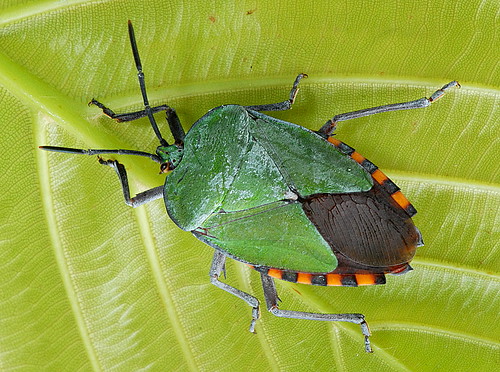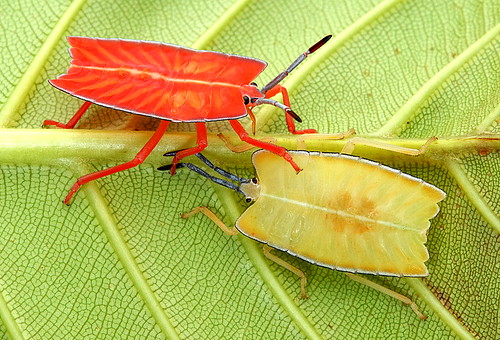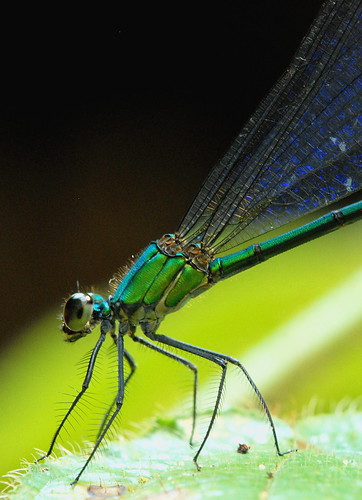Last Saturday (30 March 2009)night, went to Sungei Buloh Wetland Reserve for a night survey on Spiders. Because of raining, we were taking shelter at the Main Hide. Many of terrestrial animals "followed" us to take a shelter, including a mangrove pit viper and few caterpillars. One of the caterpillar was dropping on the back of the snake from the wooden wall when I was shooting the Pit Viper, and caused the snake to react badly. I was shock when I saw this through the camera and the snake, all of a sudden, shaking his head strongly and that cause me almost to drop my camera... 

 Ha!ha! I retreated myself in a safer distance and continue to record this interesting interaction. Eventually, the caterpillar managed to stay on the Pit Viper for about 10 minutes and them moved herself away peacefully.
Ha!ha! I retreated myself in a safer distance and continue to record this interesting interaction. Eventually, the caterpillar managed to stay on the Pit Viper for about 10 minutes and them moved herself away peacefully. 
Quite danger indeed. Should try to keep a safer distance...but somehow too greedy to get a closeup. According to the guidebook "the Amphibians & Reptiles of Singapore", "It (Mangrove Pit Viper) is usually rather bad tempered and will not hesitate to strike if approached too closely". I will think twice next time for such a "good opportunity"! 
1. NK D200, FL 90mm, 1.4xTC, 1/60sec-F/25, Manual, First Curtain flashes at -2.3ev, and -2.0ev, handheld, with ground support, Sungei Buloh Wetland Reserve, 30 Mar 2009;
2. F/11, flashes at o, and -1.7;
3. F/18, flashes at -1.3ev, and -1.0ev;
4. F/16, both flashes at -0.3ev.
Mangrove Pit Viper vs. Caterpillar
Shieldbugs-from Nymph to sub-adult
Thank Tony for spotting and sharing this particular family of bugs, to Allan for sharing this STARBUG with me to record the molting process. We were shooting the same individual and I was shooting from the side.

2- Shield Bug, Adult; FL 180mm, 1/13sec-F/22, Manual, ISO 400, fill flash, FEC -1.3 (master) & -1.7 ev (remote); tripod, MLU, CCK, Singapore, 4 Oct 2008.

3. Moult 1; FL 180mm, 1/13sec-F/22, Manual, ISO 400, fill flash, FEC -1.3 (master) & -1.7 ev (remote); tripod, MLU, CCK, Singapore, 4 Oct 2008.
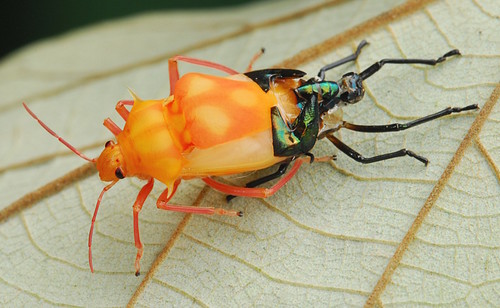
4. Moult 2, FL 180mm, 1/13sec-F/22, Manual, ISO 400, fill flash, FEC -1.3 (master) & -1.7 ev (remote); tripod, MLU, CCK, Singapore, 4 Oct 2008.
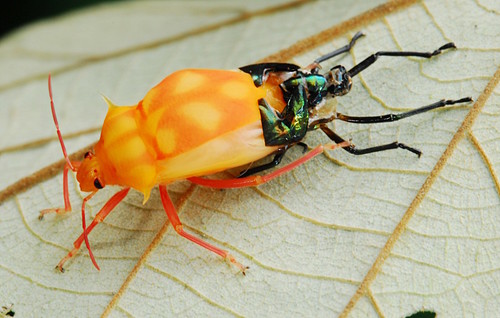
5. Moult 3; FL 180mm, 1/13sec-F/22, Manual, ISO 400, fill flash, FEC -1.3 (master) & -1.7 ev (remote); tripod, MLU, CCK, Singapore, 4 Oct 2008.

6: Moult 4; FL 180mm, 1/13sec-F/22, Manual, ISO 400, fill flash, FEC -1.3 (master) & -1.7 ev (remote); tripod, MLU, CCK, Singapore, 4 Oct 2008.

7: Out eventually! FL 180mm, 1/5sec-F/22, Manual, ISO 400, fill flash, FEC -1.3 (master) & -1.7 ev (remote); tripod, MLU, CCK, Singapore, 4 Oct 2008.
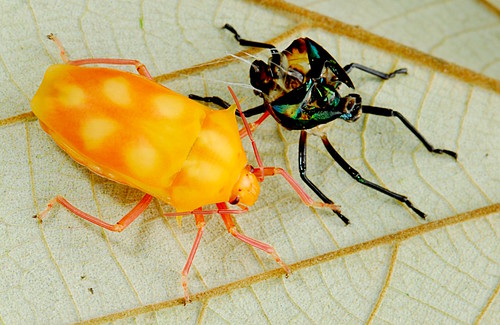
We observed several individuals and all have the same behaviour of turning themselves 180 degree after separated from the original shell (molt), then moved up to pose side by side with the molt. Got no idea of why they got such behavior!?
How many colour forms of Stinkbug (Pycanum sp) nymphs are there?
Few weeks ago (31 May 2008), I went to Eco-lake at Singapore Botanic Garden to have a macro outing with my photographic friends. The macro subjects there were not so many and not so favorable for macro shooting. So many of my friends decided to move to Holland Woods for a better luck. However, shortly after they left, myself, together with Michael, Tony, Darren and Margret were all amazed by these groups of stinkbugs, both adults and nymphs. The nymphs were exactly the some body shape, but surprisingly with totally different colour forms, i.e. red, yellow and green! We assume that all should be belonging to the same species as there were only one species of adult Stinkbug (Pycanum sp) could be found on the spot. The red color form is quite common, but the other two are all new to us. Just wondering are there any more colour forms out in the field and are there any adaptation significance for having such diverse colour forms for the nymphs? This discovery again reminds us that we know so little about the little creatures right at our backyard....
I have posted these photos in my Flickr account and many of my Flickr friends like these nymph photos very much. Some of them described these nymphs look like a piece of cutting fruit, and I do agree with that. They look so different from the adult and are really really cute. I like particularly the two showing the interaction between the yellow and the red nymphs very much...simply they look so lovely and so interesting!! :)
1. The adult: FL 180mm, 1/10sec-F/18, ISO 640, MLU, Manual, EC: -0.3 ev, Tripod, fill flash at -1.67.
2. Get in Touch: FL 180mm, 1/25sec-F/22, ISO 400, MLU, Manual, EC: +1.0 ev, Tripod, fill flash at -1.67.

3. Red and Yellow Nymphs: FL 180mm, 1/50sec-F/16, ISO 400, MLU, Manual, Tripod, fill flash at -1.67.

4. Green Nymph of Pycanum sp, dorsal view: FL 180mm, 1/30sec-F/22, ISO 400, MLU, Manual, Tripod, fill flash at -1.67.
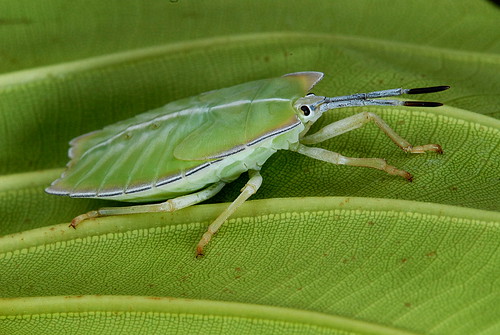
5. Green Nymph of Pycanum sp, lateral view: FL 180mm, 1/30sec-F/22, ISO 400, MLU, Manual, Tripod, fill flash at -1.67.
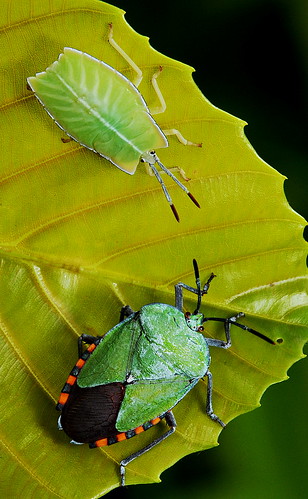
6. Mother and child: FL 180mm, 1/15sec-F/22, ISO 400, MLU, Manual, Tripod, fill flash at -1.67.
Forest Damselfly (Vestalis amethystina)
FL 180mm, 1/4sec-F/13, ISO 640, MLU, Manual, no flash, tripod, Chestnut Path, Singapore, 28 June 2008.
FL 180mm, 1/2.5sec-F/13, ISO 640, Manual, no flash, tripod, Chestnut Path, Singapore, 28 June 2008.
Singapore Asceles, a locally endemic subspecies of stick insect from Upper Peirce
Interestingly, according to their records, the food plants of this subspecies are three species of Macaranga (M. conifera, M. gigantea and M. triloba), while my specimen was tightly holding to a hairy Clidemia (Clidemia hirta). This hairy clidemia has been listed as food plant for some other species of Asceles.
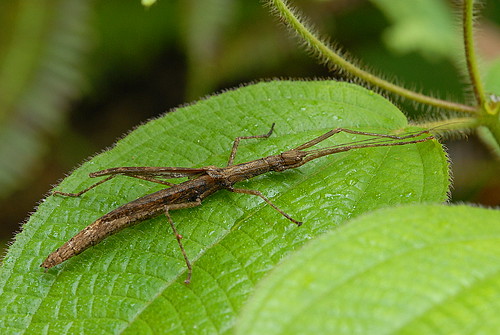
1. FL 180mm, 1/15sec-F/11, manual, ISO 640,tripod, MLU, fill flash at -2.67;
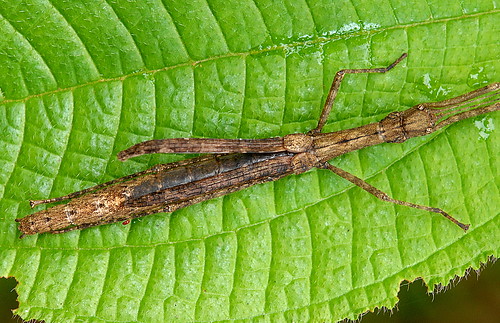
2. FL 180mm, 1/60sec-F/10, manual, ISO 640,tripod, MLU, fill flash at -2.67;

3. FL 180mm, 2x TC, 1/15sec-F/18, manual, ISO 640,tripod, MLU, fill flash at -2.67;
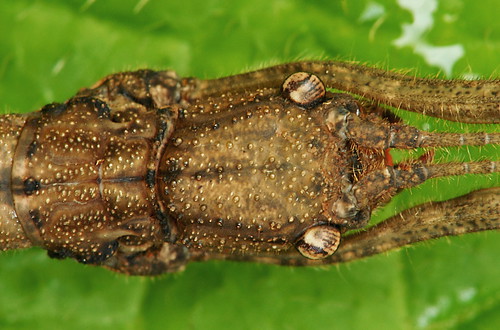
4. FL 180mm, 2x TC, 1/2sec-F/18, manual, ISO 640,tripod, MLU, fill flash at -2.67;
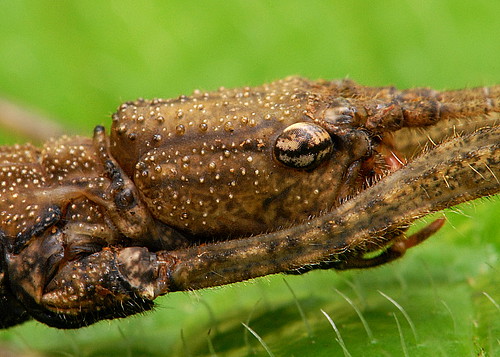
5. FL 180mm, 2x TC, 1/3sec-F/20, manual, ISO 640,tripod, MLU, fill flash at -2.67
References
Brock, P. D., 1999. Stick and leaf insects of Peninsular Malaysia and Singapore. Malasian Nature Society, Kuala Lumpur, pp. 1-222.
Seow-Choen, F., 1997. A guide to the stick leaf insects of Singapore. Singapore Science Centre, Singapore, pp. 1-160.
Seow-Choen, F., 2000. An illustratedguide to the stick and leaf insects of Peninsular Malaysia and Singapore. Natural History Publications (Borneo), Kota Kinabalu, pp. 1-173.
Seow-Choen, F., 2005. A Pocket Guide, Phasmids of Peninsular Malaysia and Singapore, Natural History Publications (Borneo), Kota Kinabalu, pp. 1-120.
Making Love: Right Time or Wrong Time-Crab Spider Story
1. The female crab spider was jumping into the mid air to catch the bee when I saw her. She grabbed the bee tightly with a single thread of silk connecting to the flower. The bee was struggling, trying to escape from the predator. But..Nowhere!! It just need a few seconds for the female crab spider to paralyze the bee...(FL 180mm, 1/40sec-F/18, ISO 400, Manual, Tripod, fill flash at -1.67ec.)
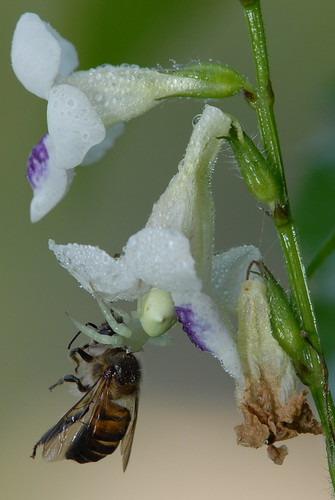
2. The spider brought back the bee to the flower where she was hiding of before. Don't know how will she handle the prey...(FL 180mm, 1/2sec-F/25, ISO 400, Manual, Tripod, fill flash at -1.67ec.)

3. Then I saw a male crab spider (the tiny brown color one) approaching to the female from behind. Thought that he was coming to help...(FL 180mm, 1/3sec-F/25, ISO 400, Manual, Tripod, fill flash at -1.67ec.)

4. When the male spider was climbing onto the female, the female was using her hind legs to kick him off several times. But as she have to hold the prey tightly at the same time, the male managed to climb up...and stick to that position for few minutes..Then just at this moment I realized that the male was most probably mating with the female. My God!!! (FL 180mm, 1/3sec-F/25, ISO 400, Manual, Tripod, fill flash at -1.67ec.)

5. The male spider left the female after he has achieved what he want, moved to a leaf above the flower to hind himself. And the female was carrying the bee moving around the flower. Eventually, she brought the bee to hind underneath another leaf at lower part of the plant, disappearing from my view... (FL 180mm, 1/3sec-F/22, ISO 400, Manual, Tripod, fill flash at -1.67ec.)
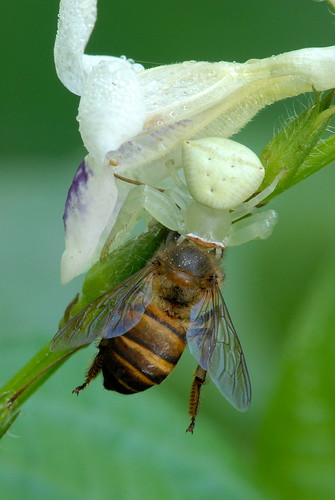
Just wondering if I interpret the observation correctly? Will the male get a piece of the prey later on?! Does he do the right thing to mate her at that point of time (assuming that my speculation is correct)? What do you think?? :P
Biodiversity Survey, Western Singapore, 14 August 2007

This was taken after a drizzle rain at the early morning.
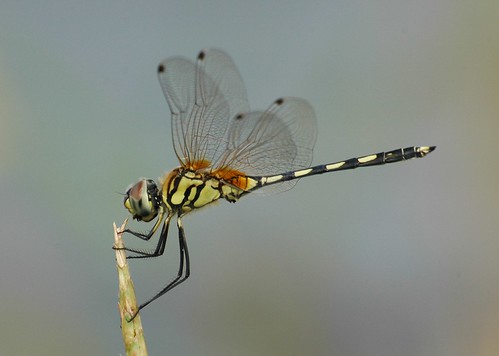
Trithemis pallidinervis, an uncommon species dragonfly in Singapore

Oxyopes birmaniscus, a common lnyx spider.
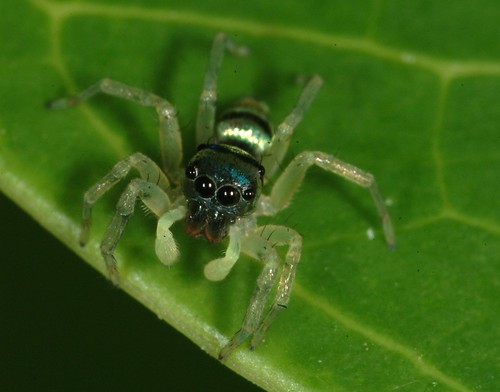
Jumping spider Phintella vittata, a common species.
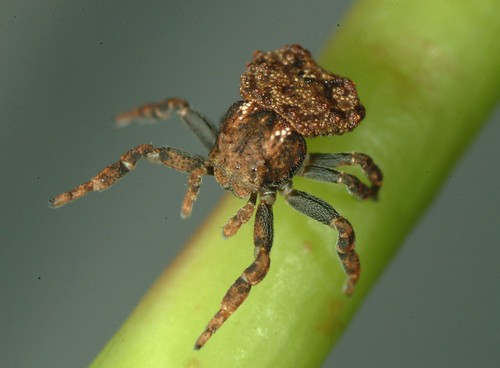
Crab spider, Boliscus tuberculata, not so easy to find in Singapore
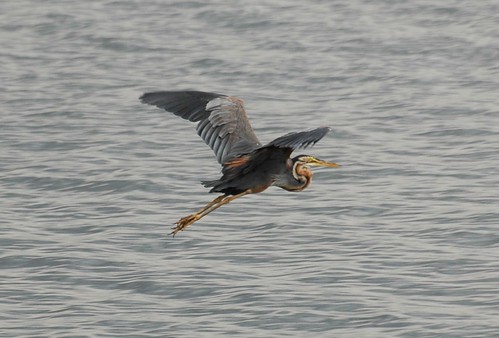
The take off of the Purple heron, Ardea purpurea.



